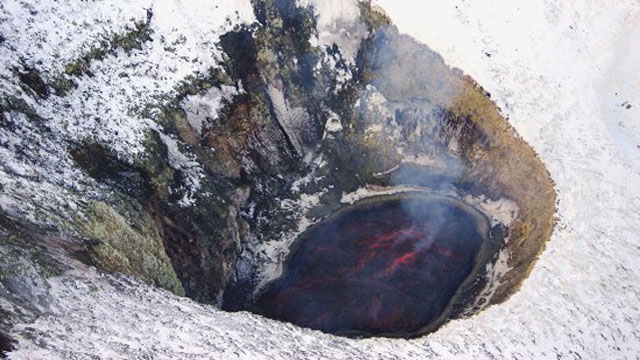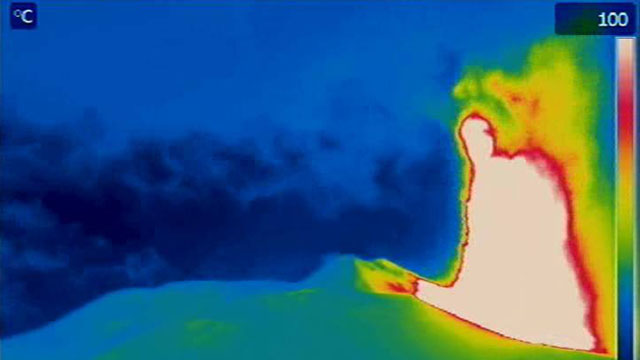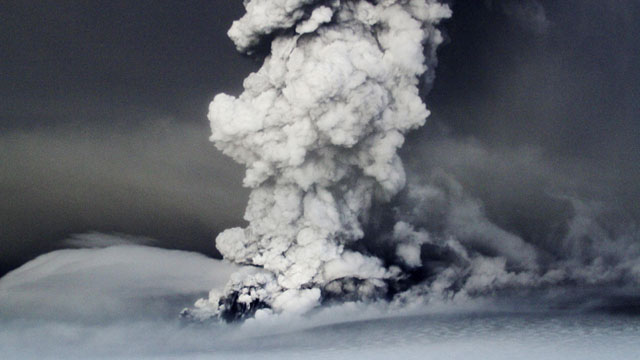Eyjafjallajökull eruption update for 4/17/2010

nThe eruptive plume from Eyjafjallajökull taken Holsvelli webcam. Image courtesy of Mattias Larsson.
nn
Sorry to disappoint everyone visiting to blog while they sit at any number of airports around the world, but the eruption at Eyjafjallajökull appears to still be going strong. The Icelandic Met Office is heading up to the volcano to conduct a survey of the crater area to find out (1) what it looks like and (2) how much new water (i.e., ice) is there available for the erupting magma. More water is likely to mean more explosive eruptions in this phreatoplinian style – however, like I mentioned yesterday, the bulk andesitic composition of the ash implies it might have a decent ability to produce explosive eruptions without a lot of extra water (but it helps). You can see a great sequence of images from the eruption on this video (although the music might not be the most fitting). It shows the “puffing” nature of the eruption, which might imply periods of melt water getting into the conduit and flashing to steam (very loosely like a geyser behaves). The Icelandic Met Office continues to have excellent information on the ash and the flooding, which has been somewhat forgotten in the news. There has been extensive flooding around the volcano due to the melting ice.
nn
The flight distruptions around Europe continue, now spreading south across most of Germany and into Italy – in all 23 European nations have total or partial flight bans. However, the ash continues to fall across England, so only limited flights are being permitted. The ash right now is estimated to be costing the airline industry $200 million dollars per day and even causing disappointment to fans of running and music. Remember, ash can destroy jet engines, as happened this week to an Finnish F/A-18 that flew into the ash – and this ash was so dilute in the air that it went unnoticed. The pictures of the damage to the engine are quite impressive. The latest ash dispersal models from the London VAAC have the ash spreading over most of northern and central Europe into Russia as the weekend progresses. The ash in Iceland itself is especially impressive as well, turning day-to-night under the main plume.
nn

nDaring pilots approaching the melting glacier near Eyjafjallajökull eruption. Torrents of meltwater can be seen in the background from the melting glacier.
nn
Eruptions readers have collected quite a bounty of excellent images from the eruption (thank you all!), so here are links to some image collections. Be sure to check out some stunning images of the eruption and lightning in the ash plume at night taken by Marco Fulle over at Stromboli Online. As usual, be sure to check out the webcams available near the volcano.
nn
UPDATE 1: Here is a recap of the explosive phase of the Eyjafjallajökull eruption from the Nordic Volcanological Centre:
nn
Explosive eruptive phase of the Eyjafjallajökull volcano, Iceland, beginsn14 April 2010nn
The eruption plume from Iceland that has caused the unprecedented
ncatastrophic disruption of air traffic and closure of airspaces over
nnorthern Europe is due to an explosive eruptive phase that began at the
nEyjafjallajökull volcano on April 14. It is a continuation of eruptive
nactivity in the Eyjafjallajökull volcanic system that began 20 March 2010.
n During an initial eruptive phase from 20 March to 12 April lava flowed
nfrom eruptive vents on the volcano flanks, outside its ice cover. The lava
nerupted in the initial phase is alkali-olivine basalt, with silica content
nof about 47%.nn
After a short hiatus in eruptive activity a new set of craters opened up
nin early morning of 14 April under the volcano’s ice covered central
nsummit caldera. This eruptive phase was preceded with a swarm of
nearthquakes from around 23:00 on 13 April to 1:00 on 14 April. The
nearthquake swarm was followed by the onset of seismic eruption tremor.
nMeltwater started to emanate from the ice cap around 7 o’clock on April 14
nand eruption plume was observed in the early morning. Visual observations
nwere limited by cloud cover over the volcano, but an airplane of the
nIceland coast Guard imaged with eruptive crates with radar instrument.
nSeries of vents along a 2 km long north-south oriented fissure were
nactive, with meltwater flowing down northern slopes of the volcano, but
nalso to the south. Ash loaded eruption plume rose to more than 8 km
nheight, deflected to the east by westerly winds.nn
Jokulhlaups (floods of meltwater) reached the lowlands around the volcano
nwith peak flow around noon on April 14, with destruction of roads,
ninfrastructure, and farmlands. No fatalities as people had been evacuated
nfrom hazardous areas. Tephra fall begins in southeast Iceland. A second
njokulhlaup/lahar emanates from the ice cap down the Markarfljot valley in
nthe evening.nn
On 15 April the eruption plume reaches mainland Europe with closure of
nairspace over large part of Northern Europe. Activity continues at a
nsimilar level with ash generation and flow of meltwater in pulses.
nJokulhlaup/lahar occurs in the evening. On April 16 some variability
noccurs in seismic tremor and tephra generation, but overall the eruptive
nactivity remains stable. Pulsating eruptive plume reaches above 8 km, with
noverall height of 5 km. Large closures of airspace continue.nn
Chemical analyses of ash samples reveal fluorine rich intermediate
neruptive products with silica content of 58%, more evolved than in the
ninitial lava producing phase of the eruptive activity. The magma
ncomposition may reflect evolution from alkali-olivine basalt by crystal
nfractionation as erupted in the initial phase.
nn
UPDATE 2: And here is a site set with all sorts of remote sensing data on the eruption, put together for IAVCEI by Simon Carn.




